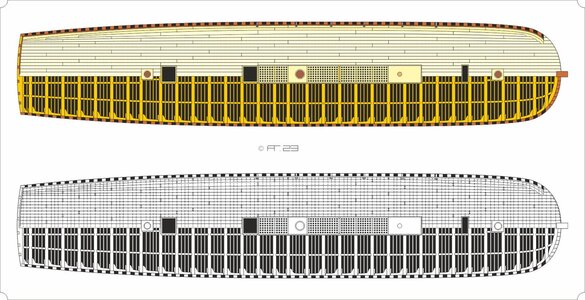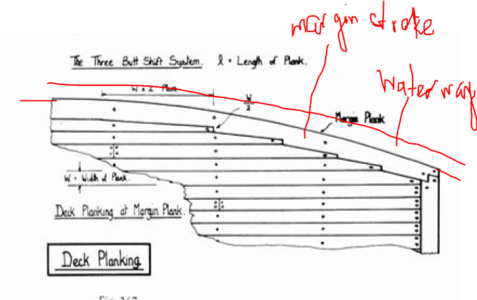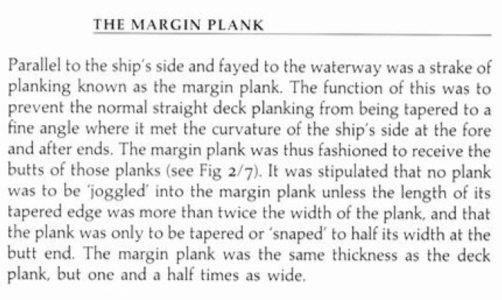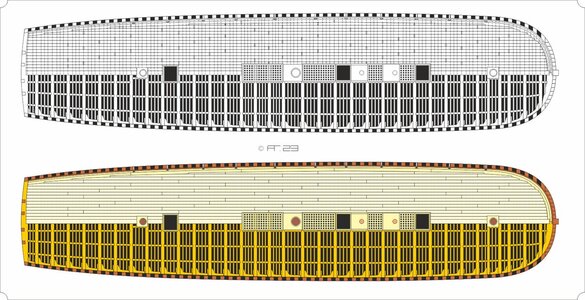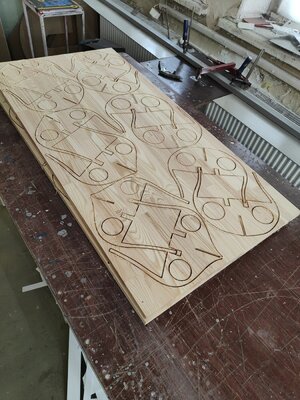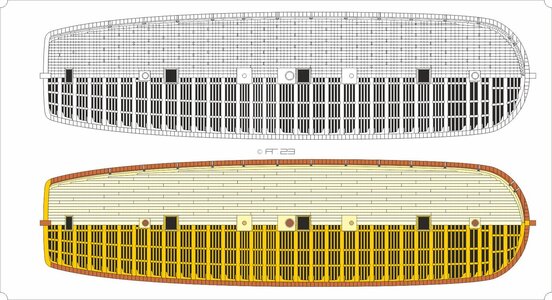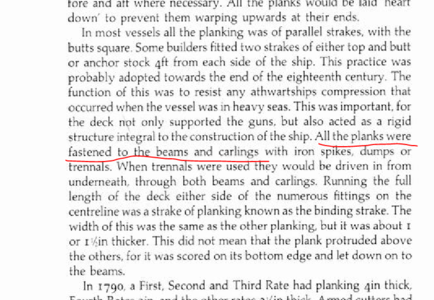I think, most probably, both features were to be present on a deck: the planks were tapered, but at the same time some of them were butted into the margin strake, which allowed for a smaller degree of tapering (compared to French decks that didn't have margin strake).
-

Win a Free Custom Engraved Brass Coin!!!
As a way to introduce our brass coins to the community, we will raffle off a free coin during the month of August. Follow link ABOVE for instructions for entering.
You are using an out of date browser. It may not display this or other websites correctly.
You should upgrade or use an alternative browser.
You should upgrade or use an alternative browser.
HMS Prince 1670 1:48
- Joined
- Dec 22, 2022
- Messages
- 131
- Points
- 213

I also looked at models and monographs, for example, in John McKay's book "Sovereign of the Seas 1637", the boards are straight with a cut into the waterway. I will make a narrowing on the visible decks, on the lower ones it will be cut.Я не знаю, для мене це дуже велика загадка про палубні дошки на англійських кораблях. Я ніде не знайшов твердого доказу, чи були дошки прямі чи звужені. Я бачив обидва варіанти. Я уважно переглянув усі моделі в USNA (у мене є 2 книги) і не побачив хорошого посилання. Більшість музейних моделей не показують палубні дошки. У різних монографіях, які я маю (Bellona, Blandford, Caroline, Pandora, Victory), також показані обидва варіанти, іноді обидва варіанти в одній монографії, тобто на одному кораблі. Наприклад, подивіться в книгу Вікторі Маккей: на одному аркуші пупдек має прямі дошки, а квартердек - конічні. Теоретичні книги (Гудвін, Лавері) також не дають точного опису. Отже... поки що я не знайшов надійного свідчення. На своєму кораблі я робив звужені дошки.
Єдині 2 речі, які зрозумілі, це маржа (на всіх колодах) і королівська дошка (на квартердеці/форкаслі та вище).
In principle it is looking very good
One question: Marked with red arrow - what is this area? Capstan? Than I wonder if the "partners" would be over the length and distantance of two beams and not only one
We can see, that you treenailed the planking also over the carlings (green arrows) - I guess this would have not been done - deckplanking was enough secured only over the beams- so everywhere were you have also the butt joints between the planks - So I think now treenailing over carlings
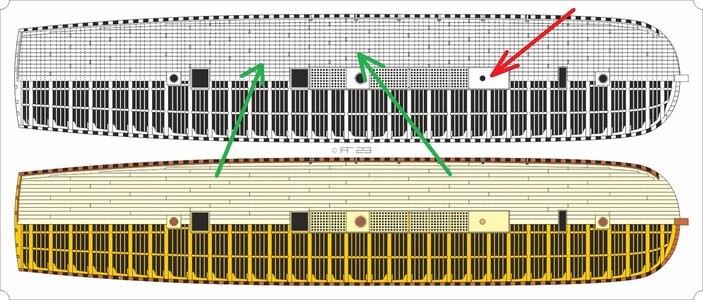
One question: Marked with red arrow - what is this area? Capstan? Than I wonder if the "partners" would be over the length and distantance of two beams and not only one
We can see, that you treenailed the planking also over the carlings (green arrows) - I guess this would have not been done - deckplanking was enough secured only over the beams- so everywhere were you have also the butt joints between the planks - So I think now treenailing over carlings

- Joined
- Dec 22, 2022
- Messages
- 131
- Points
- 213

Guided by the drawing of that time - the сapstan will be two by two.In principle it is looking very good
One question: Marked with red arrow - what is this area? Capstan? Than I wonder if the "partners" would be over the length and distantance of two beams and not only one
We can see, that you treenailed the planking also over the carlings (green arrows) - I guess this would have not been done - deckplanking was enough secured only over the beams- so everywhere were you have also the butt joints between the planks - So I think now treenailing over carlings
View attachment 394124
I saw such a picture and "stuffed" nails into the carlings, if it's wrong, I'll remove it.
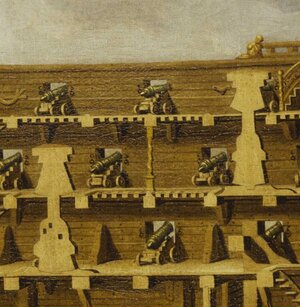
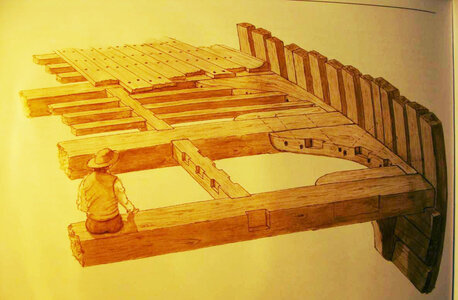
Last edited:
Anatoly, wow this will be a exciting project! I'm pulling up my shop stool to watch your build. Should be fun! Magic Mike
- Joined
- Dec 22, 2022
- Messages
- 131
- Points
- 213

looking good - but definitely I would not nail down the deck on the carlings, only on the deck beams - so only treenails where you have also the butt joints of planks
- Joined
- Dec 22, 2022
- Messages
- 131
- Points
- 213

Hello. Mr. Uwek, could you share information, or write sources, about 17th century deck nagels. But how the boards were attached to beams and carlings. Because what I found there were nails both in beams and in carlings. The truth was the Dutch. But I didn't find anything about English ships. Thank you.гарно виглядає, але точно я б не прибивав колоду на карлінгах, лише на балках палуби, тому лише дерев’яними цвяхами, де також є стикові з’єднання дощок
I have to check other resources and information given in publications
What I have in moment by hand are the drawings of Goodwins anatomy book about the HMS Granado, a 1747 buikt bomb vessel, which I am building in moment
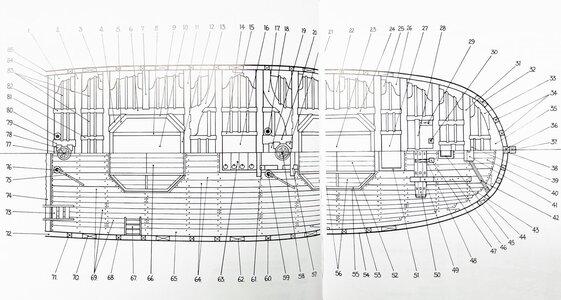
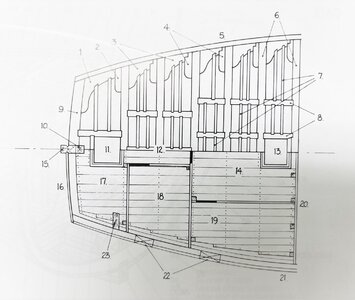
HMS Alert 1777
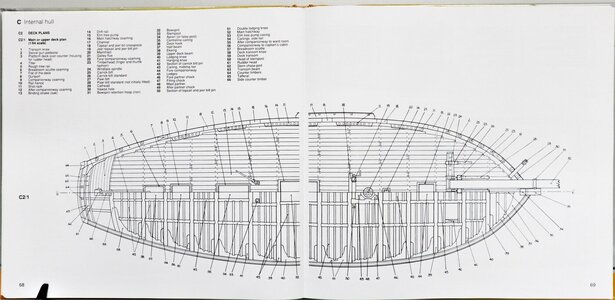
HMS Blandford 1720
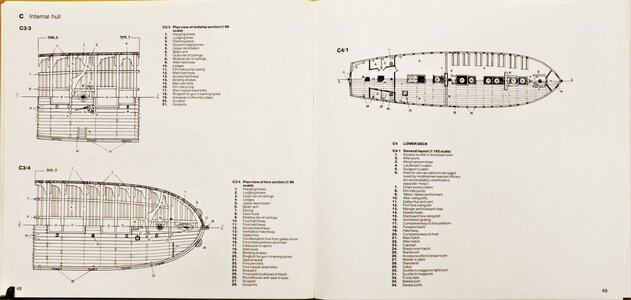
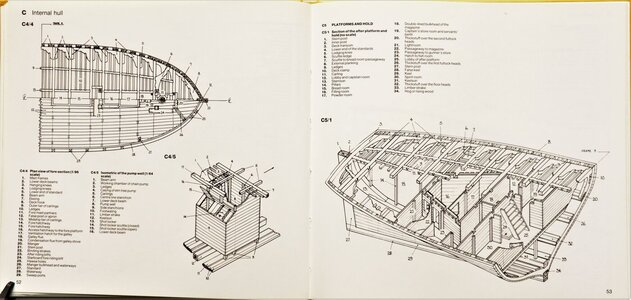
and a very bad photo (quality) of Goodwins - Construction and Fitting
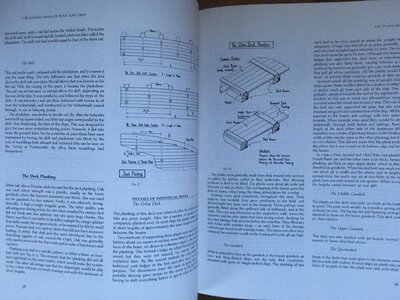
but all these information are not from contemporary resources
What I have in moment by hand are the drawings of Goodwins anatomy book about the HMS Granado, a 1747 buikt bomb vessel, which I am building in moment


HMS Alert 1777

HMS Blandford 1720


and a very bad photo (quality) of Goodwins - Construction and Fitting

but all these information are not from contemporary resources
- Joined
- Dec 22, 2022
- Messages
- 131
- Points
- 213

Thank you. I looked at the archeological researches of "Mary Rose", "Vasa", there were also nagels in the carlings, which is true, one at a time (I have two at a time). In later years (19th century) it was also found on museum drawings. But there is no information for the 17th century, 1st rank. I'm looking in books, maybe where I can find information. The question remains open... 
Consider, from another perspective, that the butt-shift of deck planking always lands on beams. With their relatively wider scantling, they can easily accommodate 2 tree-nails per plank. The carlings are of a significantly smaller scantling and there is a point of diminishing returns when it comes to piercing more holes into a plank of wood.
Yes - there is not enough space, that on both sides of the joint treenails can be installed.....the width of carlings are much smaller than of the beamsbut the planks butt joints indeed should be only on beams, not on the carlings


